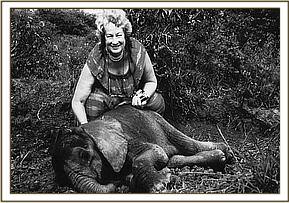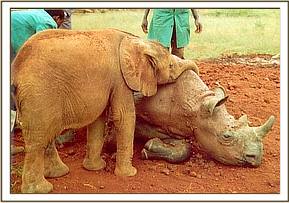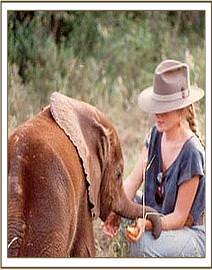

Has fully embraced his wild life in Tsavo East National Park
Current age
38 years old
Gender
Male
Rescued date
15 October 1987
Rescue location
Tsavo Ecosystem
Date of birth (estimate)
1 August 1987
Reason orphaned
Poaching
Age at rescue
2 months old (approx)
Current location
Living Wild
This was also a time when its population of elephants, which once numbered 20,000, was reduced to a mere 5 – 6,000 during 3 decades of wholesale slaughter, perpetrated “in-house” as well as by Somali insurgents. He was only about 3 months old when he lost his elephant mother and family, and was taken to the Voi Orphan Stockades behind the Tsavo East Headquarters, where the then Matriarch, “Eleanor”, immediately embraced and commandeered him, as would a mother. However, not lactating, Eleanor could not provide him with what he needed most and that was milk. Nevertheless she was still very averse to being separated from him, and in the end it was necessary to rope the calf whilst she and he were in the Night Stockades and literally drag him out in order to gain possession of him so that he could come to the Nairobi Nursery.
The name “Taru” is taken from the Taru Desert, which, in essence, is what is today’s Tsavo National National Park. Being arid semi desert country, the Taru Desert formed an effective barrier between the Coast and inland, simply an unexplored, uninhabited and hostile chunk of wilderness before the Railway opened up what was Colonial British East Africa at the turn of the 20th Century.
Elephant “Taru” was driven to the Nairobi Nursery in the back of a small Renault 4 Van, which was the only transport the Trust had at that point in time.
The Vet was hastily summoned to stich back Taru’s detached “finger” under anaesthesia, an operation that looked successful. However, it proved otherwise, because as soon as the elephant had recovered from the anaesthetic, he systematically worked on the stitches until they trailed behind him like string! Since re-stitching it seemed fruitless, and would simply subject him to the rigours of another anaesthetic, the decision was made to “let Nature take its course” and see what happened, fearing that the blood supply to the remaining “finger” would prove insufficient to save it. In fact, we were proved wrong, and Taru’s one finger remained in situ, giving him at least almost full use of the tip of his trunk.
Taru is another success story. When he was ten, he left the orphan unit, along with the other young orphaned bulls, namely Olmeg, Dika, Ndume and Edo, to seek the company of other young wild bull friends, according to the dictates of bull elephant society. Although he returned to the Stockades on several occasions these visits have become less frequent with the passing of time, and he has now been out of touch for the past 4 years. Today, like Olmeg, he would be a handsome young bull who in August 2005 will have turned 18 years of age.
This was also a time when its population of elephants, which once numbered 20,000, was reduced to a mere 5 – 6,000 during 3 decades of wholesale slaughter, perpetrated “in-house” as well as by Somali insurgents. He was only about 3 months old when he lost his elephant mother and family, and was taken to the Voi Orphan Stockades behind the Tsavo East Headquarters, where the then Matriarch, “Eleanor”, immediately embraced and commandeered him, as would a mother. However, not lactating, Eleanor could not provide him with what he needed most and that was milk. Nevertheless she was still very averse to being separated from him, and in the end it was necessary to rope the calf whilst she and he were in the Night Stockades and literally drag him out in order to gain possession of him so that he could come to the Nairobi Nursery.

View diary updates from across all our orphan units as written by the Keepers

A chance meeting turned into an incredible opportunity to help an old friend — and a reminder that elephants really never forget.
By adopting, you play a vital role in the life of an orphaned elephant, rhino, or giraffe — helping us provide the round-the-clock, loving attention each one needs and deserves over many years, so they can ultimately reclaim their place in the wild.
Your adoption supports the 100+ orphans in our care at any given time, covering the cost of milk and food supplies, Keepers' salaries, veterinary treatment, and other essentials.

Celebrate your adoption with a personalised certificate, ready for you or your lucky gift recipient to print and display!

Each month, we send a detailed update about our Orphans’ Project direct to your email inbox, featuring photos, stories, and special highlights.

From the latest Keepers’ Diaries to a downloadable image gallery and more, adopters have exclusive access to our content library.




